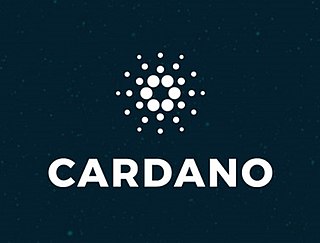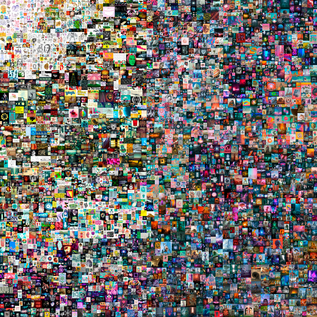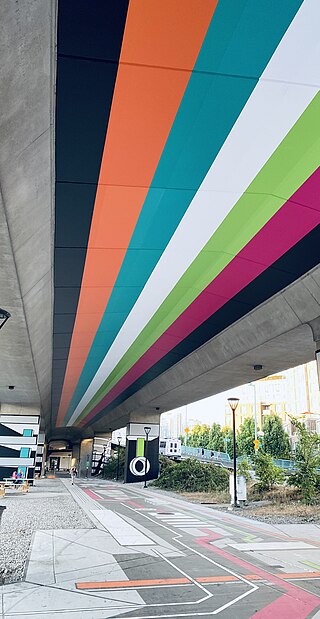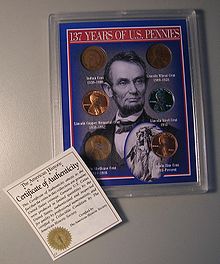
Digital art refers to any artistic work or practice that uses digital technology as part of the creative or presentation process. It can also refer to computational art that uses and engages with digital media.
In economics and law, fungibility is the property of a good or a commodity whose individual units are essentially interchangeable. In legal terms, this affects how legal rights apply to such items. Fungible things can be substituted for each other; for example, a $100 bill (note) is considered entirely equivalent to twenty $5 bills (notes), and therefore a person who borrows $100 in the form of a $100 bill can repay the money with twenty $5 bills. There is no requirement to return the same $100 bill. Non-fungible items are not substitutable in the same manner.
A deed, commonly, is a legal document that is signed and delivered, especially one regarding the ownership of property or legal rights. More specifically, in common law, a deed is any legal instrument in writing which passes, affirms or confirms an interest, right, or property and that is signed, attested, delivered, and in some jurisdictions, sealed. It is commonly associated with transferring (conveyancing) title to property. The deed has a greater presumption of validity and is less rebuttable than an instrument signed by the party to the deed. A deed can be unilateral or bilateral. Deeds include conveyances, commissions, licenses, patents, diplomas, and conditionally powers of attorney if executed as deeds. The deed is the modern descendant of the medieval charter, and delivery is thought to symbolically replace the ancient ceremony of livery of seisin.

Kevin Abosch is an Irish conceptual artist and pioneer in cryptoart known for his works in photography, blockchain, sculpture, installation, AI and film. Abosch's work addresses the nature of identity, value and human currency and has been exhibited throughout the world, often in civic spaces, including The Hermitage Museum, The National Gallery of Ireland, The National Museum of China, The Irish Museum of Modern Art, The Museum of Contemporary Art Vojvodina, The Bogotá Museum of Modern Art, ZKM, Galerie nationale du Jeu de Paume, and Dublin Airport.

Ethereum is a decentralized blockchain with smart contract functionality. Ether is the native cryptocurrency of the platform. Among cryptocurrencies, ether is second only to bitcoin in market capitalization. It is open-source software.

Cardano is a public blockchain platform. It is open-source and decentralized, with consensus achieved using proof of stake. It can facilitate peer-to-peer transactions with its internal cryptocurrency, ADA.

CryptoKitties is a blockchain game developed by Canadian studio Dapper Labs. The game allows players to buy, sell, and create non-fungible tokens (NFTs) using on Ethereum. These NFTs represent virtual cats. The game's popularity in December 2017, congested the Ethereum network, causing it to reach an all-time high in the number of transactions and slowing it down significantly.

A non-fungible token (NFT) is a unique digital identifier that is recorded on a blockchain and is used to certify ownership and authenticity. It cannot be copied, substituted, or subdivided. The ownership of an NFT is recorded in the blockchain and can be transferred by the owner, allowing NFTs to be sold and traded. Initially pitched as a new class of investment asset, by September 2023, one report claimed that over 95% of NFT collections had zero monetary value.

CryptoPunks is a non-fungible token (NFT) collection on the Ethereum blockchain. The project was launched in June 2017 by the Larva Labs studio, a two-person team consisting of Canadian software developers Matt Hall and John Watkinson. The experimental project was inspired by the London punk scenes, the cyberpunk movement, and electronic music artists Daft Punk. The crypto art blockchain project was an inspiration for the ERC-721 standard for NFTs and the modern crypto art movement, which has since become a part of the cryptocurrency and decentralized finance ecosystems on multiple blockchains.

Michael Joseph Winkelmann, known professionally as Beeple, is an American digital artist, graphic designer, and animator known for selling NFTs. In his art, he uses various media to create comical, phantasmagoric works that make political and social commentary while using pop culture figures as references. British auction house Christie's has called him "A visionary digital artist at the forefront of NFTs". Beeple was introduced to NFTs in October 2020 and credits Pak for providing his first "primer" on selling NFTs. The NFT associated with Everydays: the First 5000 Days, a collage of images from his "Everydays" series, was sold on March 12, 2021, for $69 million in cryptocurrency to an investor in NFTs. It is the first purely non-fungible token to be sold by Christie's. The auction house had previously sold Block 21, an NFT with accompanying physical painting for approximately $130,000 in October 2020.

Everydays: the First 5000 Days is a digital work of art created by Mike Winkelmann, known professionally as Beeple. The work is a collage of 5000 digital images created by Winkelmann for his Everydays series. Its associated non-fungible token (NFT) was sold for $69.3 million at Christie's in 2021, making it the most expensive non-fungible token ever.
Nifty Gateway is a digital art online auction platform for non-fungible token (NFT) art founded by Duncan and Griffin Cock Foster, and has since been acquired by the Winklevoss twins. Nifty Gateway has sold NFTs by Beeple, Pak, Refik Anadol, Sam Spratt, XCOPY, Skygolpe and other widely followed NFT artists.

Voxel Bridge is an interactive public artwork under the Cambie Bridge in Vancouver, by artist Jessica Angel. The 8,000-square-foot (740 m2) mural is a vinyl overlay on the bridge that reveals interactive elements through augmented reality (AR), with aspects of the artwork being sold as non-fungible tokens. The installation will be part of the Vancouver Biennale from summer 2021 to 2023.

Pak, formerly known as Murat Pak, is a digital artist, cryptocurrency investor, and programmer. Pak is known for creating the curation platform Archillect, an internet bot which reshares media based on user interactions with content hosted on various social platforms and for launching a platform for burning NFTs to receive tokens of the cryptocurrency Ash.
Curio Cards are collectible digital artworks located on the Ethereum blockchain. Created in 2017, Curio Cards are commonly viewed as the first digital art collectibles on the Ethereum blockchain. In October 2021, a complete collection of Curio Cards, including the card "17b" misprint, was sold for ETH393 ($1,267,320) at the Christie's Post-War to Present auction. The collection was tested for security vulnerabilities in September 2021 by softstack.
Colored Coins is an open-source protocol that allows users to represent and manipulate immutable digital resources on top of Bitcoin transactions. They are a class of methods for representing and maintaining real-world assets on the Bitcoin blockchain, which may be used to establish asset ownership. Colored coins are bitcoins with a mark on them that specifies what they may be used for. Colored coins are also considered the initial step toward NFTs built on top of the Bitcoin network.

The impact of Non-Fungible Tokens (NFTs) on traditional businesses is quantifiable in several distinct operational, transactional, and economic variables within multiple industry sectors. NFTs, characterized by their indivisibility and uniqueness, are registered on a blockchain.

The ERC-721 Non-fungible Token Standard, is a technical framework, defining a set of rules and interfaces for creating and managing unique, non-fungible tokens (NFTs) on the Ethereum blockchain. ERC-721 is recognized for formalizing the concept of an NFT and establishing the foundation of the multi-billion dollar digital collectibles ecosystem that emerged alongside its adoption. It is one of the most widely used NFT standards across use cases and has been utilized in various high profile projects.
William "Will" Entriken, also known by the online moniker Fulldecent, is a solutions architect, cybersecurity specialist, financial analyst, general manager, and civic hacker best known for his contributions in blockchain technology and open sourced solutions. He is recognized as the lead author of the landmark Ethereum paper ERC-721: Non-Fungible Token Standard, published in 2018. This paper is recognized for pioneering the foundation of the digital collectibles eco-system by establishing a programming standard called "ERC-721" to create NFTs via smart contracts on Ethereum. It also first formalized and defined the term Non-Fungible Token (NFT) into blockchain nomenclature which was made popular by the blockchain game CryptoKitties; the CTO of that game, Dieter Shirley, is also a fellow co-author of the published paper.













